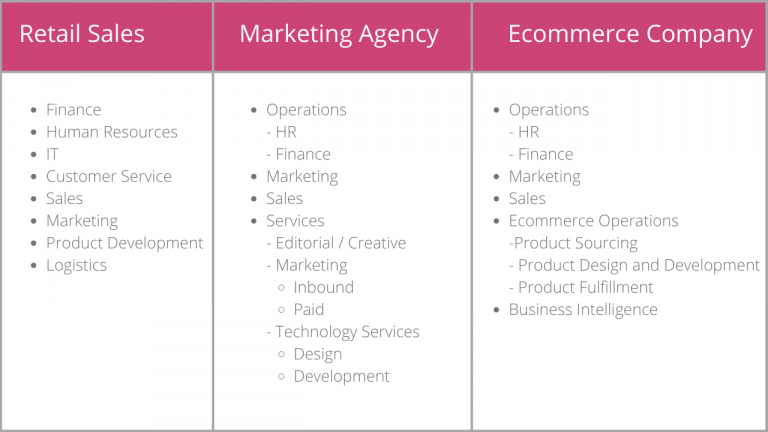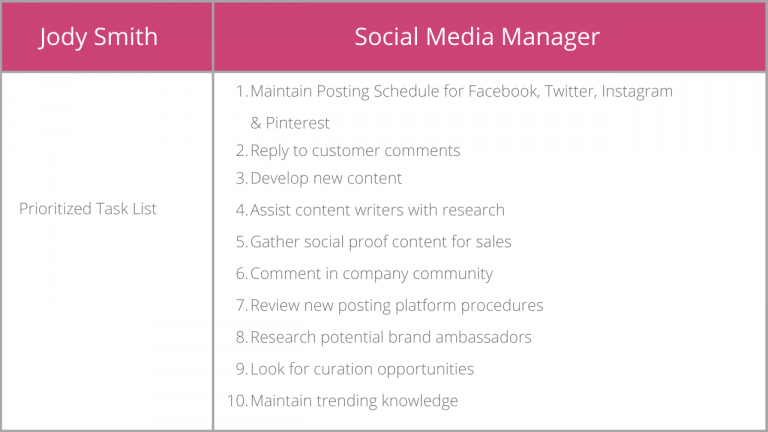The Ultimate Automation Strategy?
Systemize Your Business!

How much time do you spend managing the day to day operations of your business?
When I ask this question to most business owners they tell me, “just a few hours a day.”
Then I ask them, “How much time do you spend working on growing your business? How much time do you spend developing new marketing strategies or reviewing new innovations in your industry?”
You know what they always tell me?
“I don’t have time for that! I am way too busy running the day to day operations of my business.”
Do you see the catch 22 here?
Today I am going to show you exactly how you can systemize your business so that you can put growth back into your organization’s priority while reducing company overhead. You’ll learn the 4 key steps to systemizing your business as well as 18 of the best tips for practical systemization.
Now let’s get started!
Step 1
Map out the main departments and revenue generating tasks of your business.

This is akin to building an organization chart. Below are some examples;

If you’re a startup, you and your staff may be wearing multiple hats. That’s okay! You get to figure out exactly how everything SHOULD be run without having to redo someone else’s previous system.
Step 2
Further map departments into essential tasks and responsibilities

Look at each department of your business and think through all of the different high priority tasks that need to be completed, as well as their frequency.
Let’s use the finance department as an example. The hierarchy might look like this:
- Finance
1.1. Accounts Receivable (Daily)
1.2. Accounts Payable (Weekly)
1.3. Payroll (Bi-weekly)
1.4. End of Month close (Monthly)
1.5. End of Year close (Yearly)
Give priority to preparation
Take some time on this step. Eventually you will be creating significant rules for everyone to follow so it’s imperative that the planning stages are thoroughly thought through. Think of this process as establishing the foundation to your business. Remember, nothing grows big without a strong foundation.
You should consider interviewing your employees and gathering data about their day-to-day activities.
Most people are not natural systematic thinkers. In fact, many employees are too focused on the next thing they need to do to consider systematic task organization. As a quality, it is commonly found in executive programmers, project managers and operations professionals but it’s not common among creatives, certainly less so within marketing and sales. Consider getting assistance from people within your organization who exhibit these qualities.
How to interview your employees to participate in systemization
Prior to your interview with the employees send out an email and excel template requesting that employees list their top 10 highest priority tasks and ask them to order the tasks by degree of importance. Later, when you sit down to your meeting, gather their input into which tasks they feel could be better streamlined for efficiency. When you are done, you should have a succinct list of main priorities to focus on systemizing. This is also a good time to check-in with employees and get a good measure for how happy they are in their current role.
Now, sit down in 1:1 meetings with each of your key employees and together, work on the outline of activities that will break down into tasks. Keep your eyes open as there may be many hidden opportunities to add automations to the tasks that will boost your employees efficiency and productivity!
Here’s a sample table of how a Social Media Manager’s priority task list might look like:

Step 3
Determine which systems and procedures currently exist and assign the ones that do not.

To better understand what resources are currently available you can review assets that are on employee computers. You can note the software they are currently using and any online subscriptions that they need. Be sure to inform your employees of this review and enlist them to provide you with assistance to reduce the time you have to search.
As an aside, If your team members have documents in Word that are not in the cloud, invest in a cloud storage service like Dropbox or a Google Drive account. Sharepoint is also common but has a higher learning curve. Consider investing in G Suite – Google apps for your business.
This next part takes a little bit of project management skills. Look at what is left on your list of things that are not yet systematized, and assign an owner to each one.
Each process or system should take about 30-60 minutes to document and create. Make sure you don’t assign more than 20-40 processes to any one team member.
For example, our social media manager may have a systemized task list like this:
Maintain Posting Schedule for Facebook, Twitter, Instagram & Pinterest
- Review content management Gant
- Check Hhootsuite posting line-up
- Write creative status updates
- Check projected audience for boosted posts
Remember you want to keep your workforce agile so don’t go overboard with systemization, this is especially important if you are a start-up. Systemization can stifle creativity so make sure you strike a balance between procedure and creative work.
Step 4
Build the missing systems.

This is where most people will tell you to take it slow. They will tell you to have your employees create 1-2 systems each week over the course of a year and by the end of the year, your business will be systemized.
This never works.
Your employees are always busy. There is always a bigger priority.
To truly knuckle down, bite the bullet and have a systems week.
Systems week is the week where everyone works intensely on creating as many systems as they can in one week.
Yes, you will have to push pause on all of your other projects. But what you will have at the end of a week will enable you to grow and scale your business in a way you could never have otherwise.
If you take a whole year to systemize your business, you are literally putting your growth on hold for another year.
Still, if you truly can’t take a whole week off, take 1 day per week for the next 5-6 weeks until you are done. Make a game out of it and reward your employees to further incentivize the process. Consider pairing employees as you will undoubtable have some employees that are better at systemizing than others.
It will take an organized effort to successfully systemize your business, but with careful planning, patience, and lots of review you too can get your business operating like a well oiled machine.
If you think this blog post was a help to you, leave me a comment below!


 We’ve already talked about how LinkedIn has a new audience for you to wow with industry insights and about how it can point traffic to your business website. Those are fantastic benefits in and of themselves. But there’s more, too.
We’ve already talked about how LinkedIn has a new audience for you to wow with industry insights and about how it can point traffic to your business website. Those are fantastic benefits in and of themselves. But there’s more, too.


 Your website is optimized. You have a blog that’s updated regularly with high quality content. You’re active on social media sites like Facebook, YouTube, Twitter and LinkedIn. You focus on getting traffic rather than links to your website. Think you’ve maximized your online marketing opportunities? Think again.
Your website is optimized. You have a blog that’s updated regularly with high quality content. You’re active on social media sites like Facebook, YouTube, Twitter and LinkedIn. You focus on getting traffic rather than links to your website. Think you’ve maximized your online marketing opportunities? Think again.










 There is a saying that goes: If you aim for nothing, you will hit it every time.
This is what goes on in a lot of businesses. The business owner is so involved in just trying to get through the day to day stuff. They are busy working in their businesses not realizing that every day their competition is gaining new territory. Before they know it, the phone stops ringing and it is only then that they decide to take a look at marketing.
Don’t let the phone stop ringing.
Are you ready to create a strategic plan for your business? Isn’t it about time your brand was the one showing up all over the internet, and not your competitors?
There is a saying that goes: If you aim for nothing, you will hit it every time.
This is what goes on in a lot of businesses. The business owner is so involved in just trying to get through the day to day stuff. They are busy working in their businesses not realizing that every day their competition is gaining new territory. Before they know it, the phone stops ringing and it is only then that they decide to take a look at marketing.
Don’t let the phone stop ringing.
Are you ready to create a strategic plan for your business? Isn’t it about time your brand was the one showing up all over the internet, and not your competitors?

























